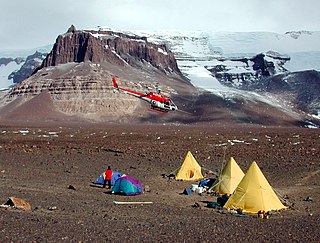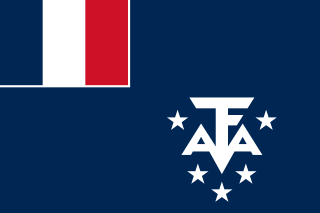Yates Glacier is a glacier 3 miles south of Matheson Glacier, discharging into the west side of Lehrke Inlet on the east coast of Palmer Land. It was named by United Kingdom Antarctic Place-Names Committee (UK-APC) after J. Yates, a British Antarctic Survey (BAS) surveyor who worked in the general vicinity of this feature.
O'Hara Glacier is a glacier just west of Ackroyd Point, flowing northwest into the south side of Yule Bay, Victoria Land. Mapped by United States Geological Survey (USGS) from surveys and United States Navy air photos, 1960-63. Named by Advisory Committee on Antarctic Names (US-ACAN) for Norbert W. O'Hara, a member of the United States Antarctic Research Program (USARP) party which conducted studies of the Ross Ice Shelf, 1965-66.

Amos Glacier is a 3-nautical-mile (6 km) long glacier that flows southeast from Bettle Peak to a juncture with the Blue Glacier, in Victoria Land, Antarctica. It was named in 1992 by the Advisory Committee on Antarctic Names after Larry Leon Amos, a civil engineer with the United States Geological Survey (USGS), and a member of the USGS two man astronomic surveying team to South Pole Station and Byrd Station in the 1969–70 field season. Among other work, the team established the position of the Geographic South Pole and established a tie to the Byrd Ice Strain net which had been under study for several years.

Beacon Valley is an ice-free valley between Pyramid Mountain and Beacon Heights, in Victoria Land. It was mapped by the British Antarctic Expedition, 1910–13, and named by the Victoria University of Wellington Antarctic Expedition (VUWAE) (1958–59) after Beacon Heights.
Carbutt Glacier is a glacier entering Goodwin Glacier to the east of Maddox Peak, close east of Flandres Bay on the west coast of Graham Land. The glacier appears on an Argentine government chart of 1954. It was named by the UK Antarctic Place-Names Committee in 1960 for John Carbutt (1832–1905), American photographer who introduced the first emulsion-coated celluloid photographic cut films, in 1888.
The Central Masson Range is the central segment of the three parts of the Masson Range, Antarctica. It rises to 1,120 metres (3,670 ft) and extends 4 nautical miles (7 km) in a north-south direction. The Masson Range was discovered and named by the British Australian New Zealand Antarctic Research Expedition, 1929–31, under Douglas Mawson. This central range was mapped by Norwegian cartographers from air photos taken by the Lars Christensen Expedition, 1936–37, and named "Mekammen". The approved name, suggested by the Antarctic Names Committee of Australia in 1960, more clearly identifies the feature as a part of Masson Range.
Vivallos Glacier is a short, steep glacier flowing north into Leith Cove, Paradise Harbor, Danco Coast. Following survey by the Chilean Antarctic Expedition, 1950–51, the glacier was named for Cabo Jose L. Vivallos, a member of the expedition.
Entrance Shoal is a small shoal, with a least depth of 7.9 metres (26 ft), just west of Entrance Island at the northwest entrance to Horseshoe Harbour in Holme Bay, Mac. Robertson Land. It was charted in February 1961 by d'A.T. Gale, hydrographic surveyor with the Australian National Antarctic Research Expeditions, and so named because of its location.

Entrikin Glacier is a broad sweeping glacier flowing eastward from the Churchill Mountains of Antarctica into Matterson Inlet. It was named by the Advisory Committee on Antarctic Names for Lieutenant Commander Joseph W. Entrikin, a U.S. Navy pilot with Squadron VX-6 during Operation Deep Freeze I, 1955–56.
Kooyman Peak is a peak rising to 1,630 metres (5,350 ft), on the ridge just south of Dorrer Glacier in the Queen Elizabeth Range, Antarctica. It was mapped by the United States Geological Survey from tellurometer surveys and Navy air photos, 1960–62, and was named by the Advisory Committee on Antarctic Names for Gerald L. Kooyman, a United States Antarctic Research Program biologist at McMurdo Station in the 1961–62, 1963–64 and 1964–65 seasons.

Fendorf Glacier is a broad glacier draining from the eastern slopes of the Gifford Peaks and flowing north to merge with Dobbratz Glacier, in the Heritage Range of the Ellsworth Mountains, Antarctica. It was mapped by the United States Geological Survey from ground surveys and U.S. Navy air photos, 1961–66, and was named by the Advisory Committee on Antarctic Names for Lieutenant Commander James E. Fendorf, U.S. Navy, a pilot with Squadron VX-6 during Operation Deep Freeze 1966.
Mount Lira is a mountain located 5 nautical miles (9 km) east of the Condon Hills, in Enderby Land, Antarctica. The geology of this feature was investigated by the Soviet Antarctic Expedition of 1961–62, which called it "Gora Lira", probably because of its shape.
McGaw Peak is a prominent peak, over 800 metres (2,600 ft) high, on the ridge between Land Glacier and Paschal Glacier in Marie Byrd Land, Antarctica. It stands midway between Mount McCoy and Pearson Peak. The peak was mapped by the United States Geological Survey from surveys and U.S. Navy aerial photographs, 1959–65, and was named by the Advisory Committee on Antarctic Names for Major Hugh R.L. McGaw, U.S. Army, a Logistics Research Officer on the staff of the Commander, U.S. Naval Support Force, Antarctica, during Operation Deep Freeze 1971 and 1972.
McSweeney Point is a sharp rock point 3 nautical miles (6 km) east of the terminus of Davidson Glacier, overlooking the Ross Ice Shelf, Antarctica. It was mapped by the United States Geological Survey from tellurometer surveys (1961–62) and Navy air photos (1960), and was named by the Advisory Committee on Antarctic Names for Lieutenant R.H. McSweeney, U.S. Navy, Commanding Officer of the USS Tombigbee during Operation Deep Freeze 1963.
Mount Hawea is a peak, 3,080 metres (10,100 ft) high, standing 4 nautical miles (7 km) east of Mount Markham in the Frigate Range, Antarctica. It was named by the northern party of the New Zealand Geological Survey Antarctic Expedition (1961–62) for the New Zealand frigate, Hawea.
Spitz Ridge is a prominent, mainly ice-covered ridge east of Cox Bluff, forming the east end of Toney Mountain, in Marie Byrd Land. Mapped by United States Geological Survey (USGS) from ground surveys and U.S. Navy air photos, 1959-66. Named by Advisory Committee on Antarctic Names (US-ACAN) for A. Lawrence (Larry) Spitz, ionospheric physicist, who wintered at Byrd Station in 1966 and worked additional summer seasons at Byrd and Hallett Station.
Horseshoe Harbour is a harbour in Holme Bay, Mac. Robertson Land, Antarctica, formed by the horseshoe-shaped rock projections of West Arm and East Arm. Mawson Station is at the head of this harbour. It was roughly mapped by Norwegian cartographers from air photos taken by the Lars Christensen Expedition, 1936–37, and rephotographed by U.S. Navy Operation Highjump, 1946–47. The harbour was first visited by an Australian National Antarctic Research Expeditions party under Phillip Law, who selected this site for Mawson Station, established on 13 February 1954.
Rabben Ridge is a small, isolated ridge about 5 nautical miles (9 km) north of Stabben Mountain in the north part of the Gjelsvik Mountains, Queen Maud Land. Mapped by Norwegian cartographers from surveys and air photos by Norwegian-British-Swedish Antarctic Expedition (NBSAE) (1949–52) and air photos by the Norwegian expedition (1958–59) and named Rabben.

Lemaire Island is an island 4.5 nautical miles (8 km) long and 1.5 nautical miles (3 km) wide, lying 1 nautical mile (2 km) west of Duthiers Point off the west coast of Graham Land, Antarctica. It was discovered by the Belgian Antarctic Expedition, 1897–99, under Adrien de Gerlache, who named it for Charles Antoine Lemaire. The island is bordered by the Aguirre Passage which separates it from the Danco Coast.






